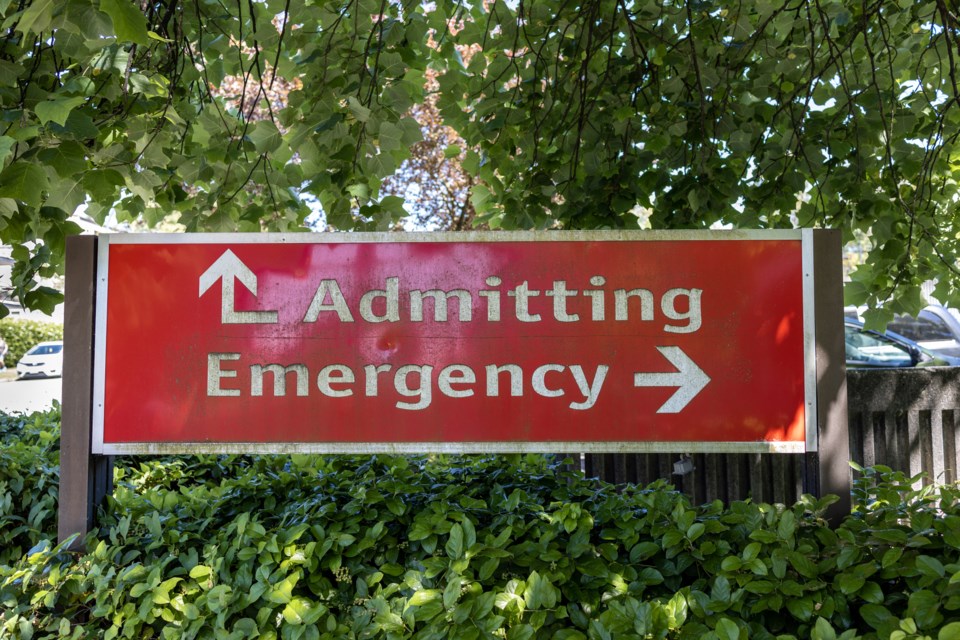The province’s emergency rooms are in crisis.
ERs across the Lower Mainland have made the news for being at capacity and past their breaking points. This overcrowding led to the death of an infant in 2020 and a senior in 2022.
Doctors have even been urging people to stay away and seek help elsewhere. In the Lower Mainland one in 10 patients are leaving ERs without seeing a doctor, according to reporting by CTV.
Patients are also dying while waiting to access emergency care across the province. Two patients died while waiting for care at the Royal Inland Hospital in Kamloops and two people died in Ashcroft last year because the community’s local ER was closed.
The Tyee set out to explore whether rural jurisdictions are suffering as much as major metropolises.
To find out, The Tyee reached out to Vancouver Coastal Health, Fraser Health, Interior Health, Island Health and Northern Health authorities, and Providence Health Care. The Tyee also contacted the First Nations Health Authority but did not hear back.
We wanted to know if emergency departments in these authorities had to close, and how many patients they’d had to divert. Were the closures and capacity issues all due to staffing shortages?
The Tyee asked health authorities to share data on all service interruptions from the start of 2019, the location, date, length of service interruption, reason for service interruption and total number of patients impacted.
We learned that while ER departments in the Lower Mainland may be swamped, they’re able to keep their doors open.
That’s not the case for many rural emergency care centres across the province.
The data highlights just how seriously the COVID-19 pandemic has impacted health care across the province, with almost no service interruptions in 2019 and 2020 and a spike in 2021, 2022 and again in 2023, with the number of service interruptions this year so far set to match last year’s totals.
Each health authority reported its ER closures differently.
Vancouver Coastal Health and the Provincial Health Services Authority, which manages the BC Children’s Hospital, said they had no service interruptions, so they don’t show up on the chart.
Fraser Health has had a handful of service interruptions, but largely for events outside of its control, like a fire or police incident.
Interior Health sent The Tyee a spreadsheet with locations and dates but didn’t provide a reason for service interruptions.
None of the health authorities said they tracked the number of patients impacted.
In an email, Northern Health said it only “recently began tracking emergency department service interruptions and [did] not have this data readily available for previous years going back to 2019.”
The authority could only provide data from February 2023 to June 20, 2023. There have been no “prolonged closures of hospital emergency departments” and the data mostly covers intermittent shift-by-shift service interruptions, it added.
Island Health invited The Tyee to review press releases posted on its website to find the data we were seeking. In the graph below, we counted a half-day closure, where an emergency department cut either its morning or evening hours, as a service interruption. If a service interruption lasted six hours or more, we counted it.
Island Health also had a lot of nighttime closures, where an emergency department was shut down from 7 p.m. and opened at 7 a.m., for example.
It’s not clear if other health authorities included half-day or nighttime service interruptions in the data they shared with The Tyee.
While many emergency departments had a handful of service interruptions, some places have a much more long-term struggle to keep their doors open.
Several places on Vancouver Island had more than 100 service interruptions. Many of those were because an ER shut down overnight.
We’ve colour-coded the facilities in the graph below: blues are managed by Island Health, greens by Northern Health and yellows by Interior Health. The other health authorities do not appear on this graph because they did not have facilities with more than 20 total service interruptions over the five years.
Cormorant Island Health Centre is located in Alert Bay, the remote community of the Na̱mǥis First Nation on Cormorant Island. The next closest emergency room is in Port McNeill, a 45-minute BC Ferries ride away, with the ferry running six times a day from 9:30 a.m. to 10:30 p.m. When a ferry isn’t available, BC Ambulance will charter a boat, airlift a patient to the next best care facility or even call in the Coast Guard to transport a patient.
The facility with the second-highest number of service interruptions is Port Hardy Hospital on the northeastern coast of Vancouver Island. Patients unable to access care there likely would have also been diverted to Port McNeill, a half-hour drive away.
Port McNeill Hospital had 19 days of service interruptions in 2022 due to staffing shortages. In a press release about the closures Island Health said patients should, if possible, head to Port Hardy Hospital. Island Health told The Tyee it was aware of the nursing staffing shortages that led to these closures and had intentionally scheduled closures so it could consolidate staff and ensure either Port McNeil Hospital or Port Hardy Hospital ER stayed open. The staffing situation is “stabilizing” and so far at least one major hospital ER department has been open at all times, Island Health said.
If there was an emergency and both hospital ERs had to close, patients would be diverted to Campbell River Hospital, a 2½ hour drive away from Port Hardy Hospital, Island Health added.



